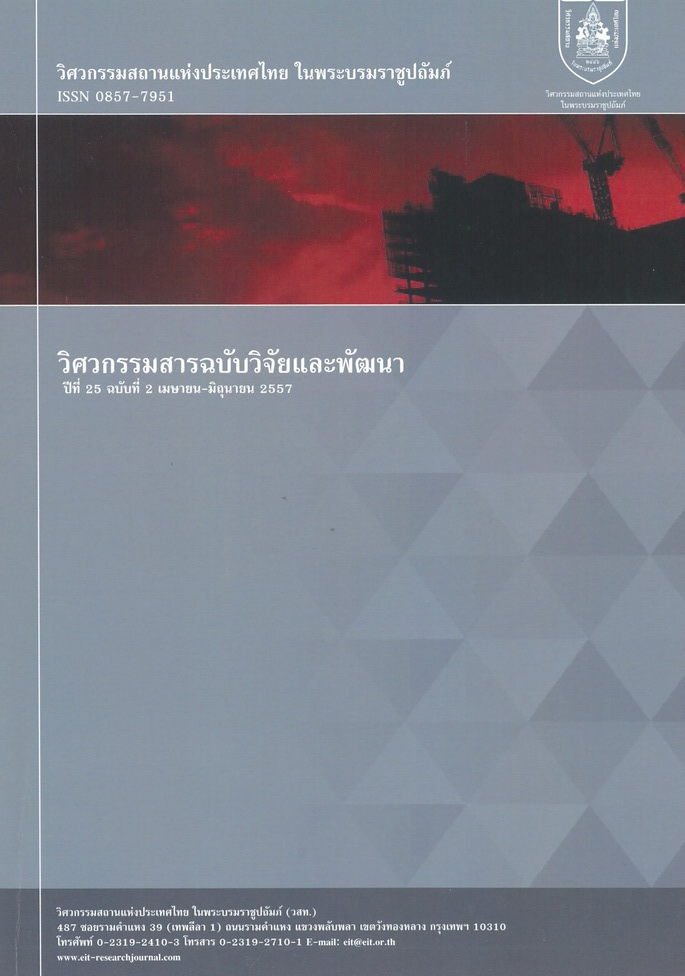COMBUSTION OF BIO-DIESEL OIL ON THE PACKED-BED SPHERE POROUS BURNER STRUCTURED AS HOMOGENEOUS AND SEMI-HOMOGENEOUS
Main Article Content
Abstract
บทความวิจัยนี้เป็นการทดลองใช้น้ำมันไปโอดีเซลเป็นเชื้อเพลิงในหัวพ่นไฟวัสดุพรุน เพื่อศึกษากลไกการระเหยของน้ำมันเชื้อเพลิงและพฤติกรรมการเผาไหม้ วัสดุพรุนที่ใช้ในการทดลองเป็นชนิดเม็ดกลมอัดแน่นที่มีการจัดเรียงตัวกัน 2 รูปแบบ ได้แก่ แบบเนื้อเดียวซึ่งเลือกใช้เซรามิกซ์ ชนิดคอร์ดิไรท์ ที่มีค่าความพรุน เท่ากับ 0.391 และอีกแบบคือแบบกึ่งเนื้อเดียวจะเลือกใช้หินตู้ปลาที่มีค่าความพรุน เท่ากับ 0.395 ตามลำดับ น้ำมันเชื้อเพลิงป้อนเข้าสู่ระบบด้วยการหยดจากด้านบนผ่านชั้นวัสดุพรุน เกิดการระเหยกลายเป็นไอ นำไปสู่การเผาไหม้บริเวณด้านล่างชั้นวัสดุพรุน อุณหภูมิตลอดแนวความยาวของหัวพ่นไฟถูกตรวจวัดและแสดงในลักษณะโครงสร้างทางอุณหภูมิ ขณะเดียวกันแก๊สไอเสียถูกตรวจวัดที่ตำแหน่งด้านออกของระบบ จากการทดลองพบว่าเมื่อเพิ่มอัตราการจ่ายอากาศหมุนวน (QA) โครงสร้างทางอุณหภูมิมีแนวโน้มลดลงในวัสดุพรุนทั้ง 2 รูปแบบ แต่มีแนวโน้มเพิ่มขึ้นตามอัตราการจ่ายน้ำมันเชื้อเพลิง (QF) และได้ข้อสังเกตที่น่าสนใจคือ โครงสร้างทางอุณหภูมิของหัวพ่นไฟแบบหินตู้ปลาจะมีค่าสูงกว่าแบบเซรามิกซ์คอร์ดิไรท์ สำหรับปริมาณ CO และ NOX ที่ปล่อยออกมาจากหัวพ่นไฟวัสดุพรุนชนิดเม็ดกลมอัดแน่นของงานวิจัยนี้ อยู่ในเกณฑ์ที่ต่ำยอมรับได้
This research investigated the experiment of using Bio-diesel oil as fuel in porous burner to investigate evaporation mechanism and combustion behavior. There are two appearance structures of packed-bed sphere porous media, i.e., homogeneous and semi- homogeneous models, were used. The first one, homogeneous structure, was employed by Cordierite ceramic having porosities of 0.391. On the other hand, the pebble having porosities of 0.395 was chosen as semi-homogeneous structure. The fuel was supplied drop-wise from the top through the porous burner and evaporated in the porous media followed by the combustion on the bottom side. Axial profiles of temperature along the burner length were measured The pollutant-emission characteristics were also monitored at the burner exit. From the study, it was found that the temperature profile of the both cases decreased with the flow rate of swirling air (QA) increasing. The temperature profile explicitly increased with the rate of fuel input (QF) Remarkably, the temperature profile of the pebble case was higher than those of the Cordierite ceramic case. The levels of CO and NOX in the present packed-bed sphere porous burner were acceptable range.
Article Details
The published articles are copyright of the Engineering Journal of Research and Development, The Engineering Institute of Thailand Under H.M. The King's Patronage (EIT).

